
In my July post, I noted that Section 101 court decisions were issuing fast and furious, with twelve decisions in just the first ten days. I predicted that "At this pace, we could see some twenty to thirty decisions this month."
Sadly, I was spot on: there were 21 decisions, with 17 of those (81%) invalidating 36 patents. With those cases, and the cases through August 26, these are the current #AliceStorm numbers:
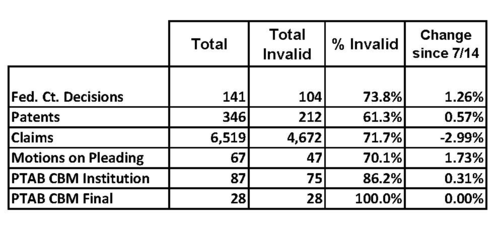
Compared to the last numbers from July, the invalidity decision rate is up a tick, patent invalidity percentage is essentially unchanged, and claims are down a bit. No surprise, PTAB continues its 100% kill rate on final CBM decisions.
Here are the motion numbers:
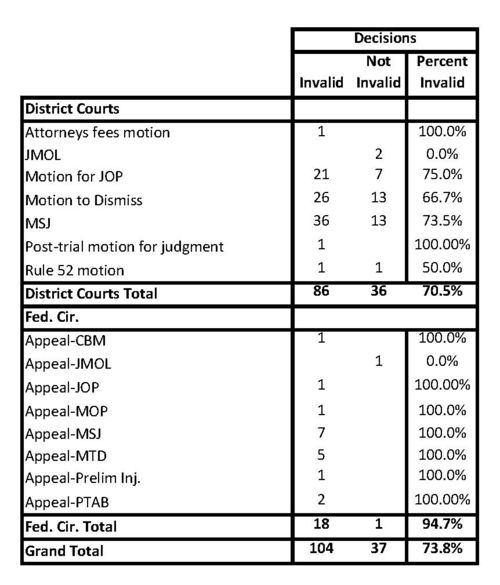
The Federal Circuit numbers jumped from 16 to 19 decisions because there were two per curiam affirmances of invalidity in July and August, and one we picked up from before. Successful motions for JOP are up 3% to 75%, while successful motions to dismiss ticked up 1.1%.
As to tribunals:
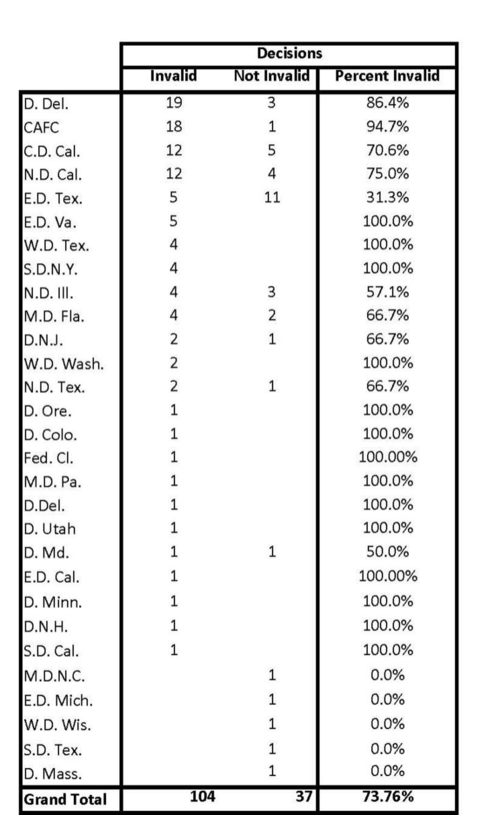
The Northern District of California showed a slight increase, up 1.7% to a 75% invalidity grant on all Section 101 based motions.
One of the questions that comes up is how the numbers compare before and after Alice. To determine this, I looked at the 14 month periods before and after Alice. Here are the results:
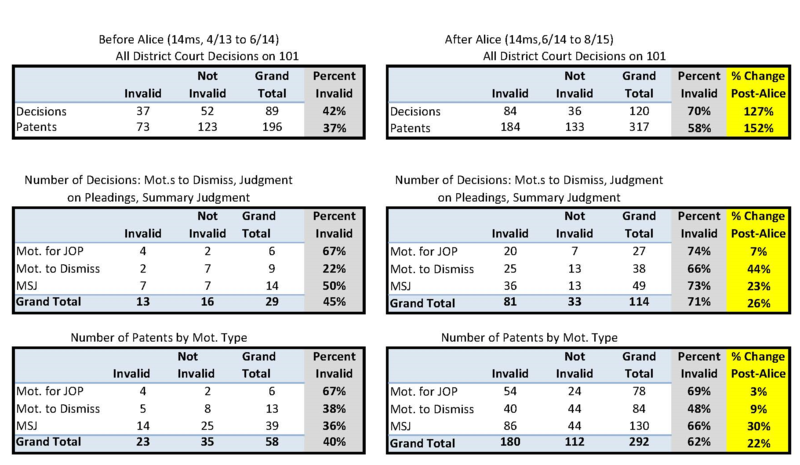
Note that the percent change post-Alice for decisions and patents is calculated with respect to the raw counts of decisions and patents, not with respect to the invalidity percentages.
To put this in perspective: the courts invalidated more patents in the 14 months since Alice, then they did in the five years previous to Alice.
Is that what the Supreme Court intended when the cautioned the courts to "tread carefully in construing this exclusionary principle lest it swallow all of patent law."?
What's Up at the USPTO? Section 101 Rejection Rates, Of Course
With the assistance of Patent Advisor, I now have about 570,000 records of office actions and notices of allowance from the last year or so. The most recent update I received just over 79,000 office actions and allowances:
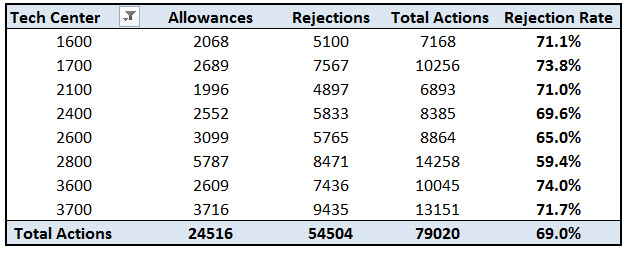
Overall, the rejection rates for all kinds run about 69%, with TC 3600 just marginally higher. But as I've explained, looking at TC 3600 as whole hides the real rejection rates for patent eligibility.
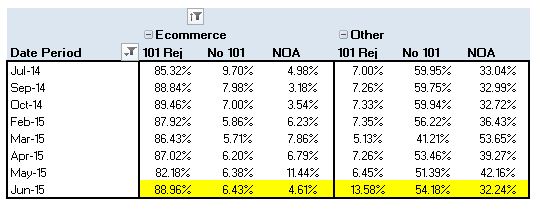
Here, I have the percentages of Section 101 rejections in each of the identified months, broken out between the e-commerce art units (3620, 3680 and 3690) and all other art units at the USPTO (i.e., biotech, communications, computers, etc.). As you can see, the ecommerce examiners are continuing to issue 101 rejections at a very high rate, almost 87% in June. What's more, the percentage of notices of allowance dropped dramatically in the ecommerce units, from 11.44% to just 4.6% in June.
Perhaps more disconcerting, is that even in other art units, the 101 rejection rate more than doubled, from 6.45% to over 13%, and the notice of allowance rate dropped. Can it really be that so many thousands of patent applications merely claim abstract ideas?
Let's look at the rejection rates for June, specifically, organized by technology area:

This is a cross-functional summary, in that I've aggregated the rejection rates according to the kinds of technology, which extends across different Tech Centers, or I've extracted technologies from within Tech Centers. For example, I've pulled Medical and Drugs out TC 1600, and Transportation out of TC 3600, in which it's lumped in with business method patents. I've moved Amusement and Education, which are in TC 3700, to the Commerce group to join with the e-commerce technology from TC 3600. Again we see the extraordinary percentage of Section 101 rejection rates in Commerce (and the correspondingly low notice of allowance rates), relative to other technology areas.
USPTO Stats Confirm the Alice Effect
The USPTO The USPTO just released statistics on patent application filing, pendency, and so forth. New patent applications are expected to decline by 1.8% overall in FY2015, even though the Office expected 5% growth, continuing a six year growth trend.
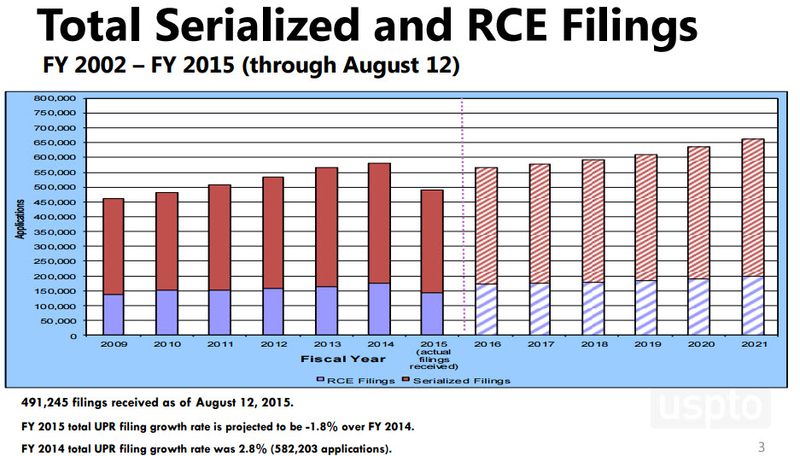
Even more interesting is that RCE filings are down about 6% as well, RCE's being the typical mechanism we use to continue to push for allowance. TC 3600 had the sharpest drop in RCE filings in particular.

And, no surprise, the drop in total filings (new and RCE) was most pronounced in TC 3600. Without having the actual data, it's hard to exactly confirm, but from the below it appears that most TC's are flat or have a tiny decline in filings. Along with the RCE drop in TC 3600, that suggests that TC 3600 is contributing the most to the overall decline in applications filings. The upshot: Alice is having real measurable impact on application filings.
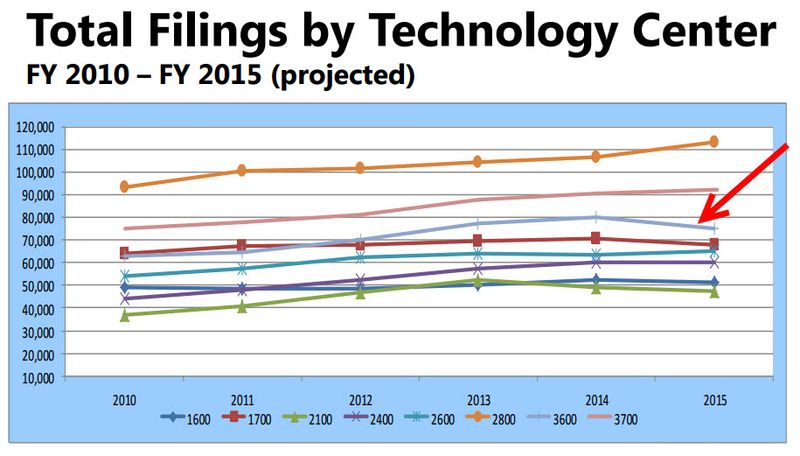
If these trends on 101 rejections continue, then examiners are working themselves out of a job, and the USPTO is working itself in the red. Fewer applications does not mean reduced pendency. Instead it means fewer examiners because there will less fee income coming into the USPTO to pay examiners--fees from new applications, fees from extensions of time, fees for everything. And in the long run, it means less maintenance fees, which are already back-end loaded, to pay future examiners. This is the law of unintended consequences at work.
There Ain't No Cure for the 101 Blues...
Now some anecdotal evidence.
First, as many of you know, immediately after Alice the USPTO did a sweep of all cases with notices of allowance--and even paid issue fees--to review for Alice rejections. The Office stated publicly at AIPLA Spring and other venues that this was a one-time deal, and that they were not going to do any further post-issuance review to issue Section 101 rejections. However, the Office appears to have gone back on its statement. Just last week, one of our cases in TC 3600, on which we had received a notice of allowance and immediately paid the issue fee, was yanked back without explanation.
Similarly, we have an application in TC 3600 art unit that has allowed just 7 patents in the past 6 months (with 118 cases being abandoned). We appealed a Section 101 rejection. We were pleased, to say the least, when the examiner withdrew the final rejection after apparently reading our appeal brief, and issued a notice of allowance. We were not so pleased when just three days later we received a notice of withdrawal of the allowance! We called the SPE and were told that the allowance "was a mistake," and the examiner was being instructed to file an answer to the appeal brief.
It also appears that the USPTO is targeting patent applications for disposals based on Alice. Consider two applications filed on May 12, 2014, 14/275,026 and 14/275,094, both of which are continuations and both assigned to the same examiner. The initial claims in the ‘094 mentioned accounting, and that application has already received two non-final office actions, both including an Alice rejection; the first rejection was issued on June 29, 2014, just over a month after filing. The ‘026 had no such language and has not even been examined yet. I could understand a month or two difference in the timing of office actions but not more than a year, given that they have the same examiner. This suggests that the USPTO is focusing on the '094 application precisely because of its accounting-oriented claims.
And then there's this tale: Earlier this week I had an interview with a primary examiner in a business methods art unit to discuss a 101 rejection, where there were no prior art rejections. As you know, a primary examiner in theory has authority to allow an application. Well, I stress "in theory" because when it comes to 101 rejections in the business methods units, it appears that even if you convince the primary, he still needs to get approval from both his supervisor and a legal specialist.
This poor fellow has not allowed a case in over year—but not for want of trying. He told me that he’s had a couple of cases where he was willing to allow the application and withdraw the 101 rejection—but his SPE and the specialist overruled him. It was pretty clear that he was frustrated by the entire process. And that very frustration made it more or less impossible for him to offer any suggestions as to what to do, since he figured that anything he suggested would get overruled by his superiors: all he would say is "Read the Interim Guidance and the July examples, they tell you what to do." He also admitted that he was concerned with getting dinged by the quality assurance reviewers, who scrutinize applications and penalize the examiners for making mistakes—such as allowing a case they should have rejected under Alice. Thus, with the odds and the incentives stacked against him, he was, by his own admission, just waiting out the final two years before he retires.
That makes him the lucky one.
The rest of us are going to be around for a while.